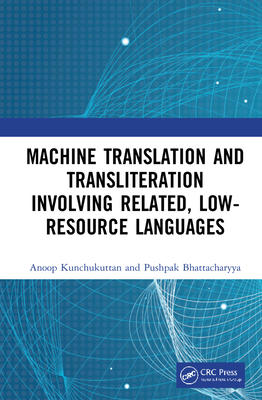Machine Translation (Hardcover)
暫譯: 機器翻譯 (精裝版)
Pushpak Bhattacharyya
- 出版商: CRC
- 出版日期: 2015-01-22
- 售價: $2,980
- 貴賓價: 9.5 折 $2,831
- 語言: 英文
- 頁數: 260
- 裝訂: Hardcover
- ISBN: 1439897182
- ISBN-13: 9781439897188
-
相關分類:
人工智慧、Machine Learning、語音辨識 Speech-recognition
立即出貨 (庫存 < 3)
買這商品的人也買了...
-
 電磁學 (Field and Wave Electromagnetics, 2/e)
電磁學 (Field and Wave Electromagnetics, 2/e)$950$903 -
 深入淺出 Java 程式設計, 2/e (Head First Java, 2/e)
深入淺出 Java 程式設計, 2/e (Head First Java, 2/e)$880$695 -
 C++ Primer, 4/e (中文版)
C++ Primer, 4/e (中文版)$990$891 -
 Integrated Circuit Design, 4/e (IE-Paperback)
Integrated Circuit Design, 4/e (IE-Paperback)$1,580$1,568 -
 大話資料結構
大話資料結構$590$502 -
 JavaScript 大全, 6/e (JavaScript: The Definitive Guide: Activate Your Web Pages, 6/e)
JavaScript 大全, 6/e (JavaScript: The Definitive Guide: Activate Your Web Pages, 6/e)$1,200$948 -
 無瑕的程式碼-敏捷軟體開發技巧守則 (Clean Code: A Handbook of Agile Software Craftsmanship)
無瑕的程式碼-敏捷軟體開發技巧守則 (Clean Code: A Handbook of Agile Software Craftsmanship)$580$452 -
 自動控制, 6/e
自動控制, 6/e$630$567 -
 Arduino 基礎入門套件 (附範例程式下載連結)
Arduino 基礎入門套件 (附範例程式下載連結)$950$903 -
 精通 Python|運用簡單的套件進行現代運算 (Introducing Python: Modern Computing in Simple Packages)
精通 Python|運用簡單的套件進行現代運算 (Introducing Python: Modern Computing in Simple Packages)$780$616 -
 完整學會 Git, GitHub, Git Server 的24堂課
完整學會 Git, GitHub, Git Server 的24堂課$360$284 -
 不一樣的 Node.js:用 JavaScript 打造高效能的前後台網頁程式, 2/e
不一樣的 Node.js:用 JavaScript 打造高效能的前後台網頁程式, 2/e$490$387 -
 Raspberry Pi 3 Model B (Made in the U.K.)
Raspberry Pi 3 Model B (Made in the U.K.)$1,600$1,600 -
 圖解!大數據下必學的統計基礎
圖解!大數據下必學的統計基礎$350$277 -
 Python 函式庫語法範例字典
Python 函式庫語法範例字典$450$356 -
 React 啟動與運行 (React: Up & Running: Building Web Applications)
React 啟動與運行 (React: Up & Running: Building Web Applications)$580$458 -
 Android App 程式設計教本之無痛起步 -- 使用 Android Studio 2.X 開發環境
Android App 程式設計教本之無痛起步 -- 使用 Android Studio 2.X 開發環境$580$458 -
 $331優雅的 Ruby (Confident Ruby)
$331優雅的 Ruby (Confident Ruby) -
 圖解雲端技術|基礎架構x運作原理 x API
圖解雲端技術|基礎架構x運作原理 x API$480$379 -
 資料視覺化|使用 Python 與 JavaScript (Data Visualization with Python and JavaScript: Scrape, Clean, Explore & Transform Your Data)
資料視覺化|使用 Python 與 JavaScript (Data Visualization with Python and JavaScript: Scrape, Clean, Explore & Transform Your Data)$680$537 -
 無瑕的程式碼-敏捷完整篇-物件導向原則、設計模式與 C# 實踐 (Agile principles, patterns, and practices in C#)
無瑕的程式碼-敏捷完整篇-物件導向原則、設計模式與 C# 實踐 (Agile principles, patterns, and practices in C#)$790$672 -
 Effective C# 中文版 | 寫出良好 C# 程式的 50個具體做法, 3/e (Effective C# : 50 Specific Ways to Improve Your C#(Covers C# 6.0), 3/e)
Effective C# 中文版 | 寫出良好 C# 程式的 50個具體做法, 3/e (Effective C# : 50 Specific Ways to Improve Your C#(Covers C# 6.0), 3/e)$450$356 -
 TensorFlow + Keras 深度學習人工智慧實務應用
TensorFlow + Keras 深度學習人工智慧實務應用$590$460 -
 白話大數據與機器學習
白話大數據與機器學習$480$379 -
 寫程式前就該懂的演算法 ─ 資料分析與程式設計人員必學的邏輯思考術 (Grokking Algorithms: An illustrated guide for programmers and other curious people)
寫程式前就該懂的演算法 ─ 資料分析與程式設計人員必學的邏輯思考術 (Grokking Algorithms: An illustrated guide for programmers and other curious people)$390$308
相關主題
商品描述
Three paradigms have dominated machine translation (MT)—rule-based machine translation (RBMT), statistical machine translation (SMT), and example-based machine translation (EBMT). These paradigms differ in the way they handle the three fundamental processes in MT—analysis, transfer, and generation (ATG). In its pure form, RBMT uses rules, while SMT uses data. EBMT tries a combination—data supplies translation parts that rules recombine to produce translation.
Machine Translation compares and contrasts the salient principles and practices of RBMT, SMT, and EBMT. Offering an exposition of language phenomena followed by modeling and experimentation, the text:
- Introduces MT against the backdrop of language divergence and the Vauquois triangle
- Presents expectation maximization (EM)-based word alignment as a turning point in the history of MT
- Discusses the most important element of SMT—bilingual word alignment from pairs of parallel translations
- Explores the IBM models of MT, explaining how to find the best alignment given a translation pair and how to find the best translation given a new input sentence
- Covers the mathematics of phrase-based SMT, phrase-based decoding, and the Moses SMT environment
- Provides complete walk-throughs of the working of interlingua-based and transfer-based RBMT
- Analyzes EBMT, showing how translation parts can be extracted and recombined to translate a new input, all automatically
- Includes numerous examples that illustrate universal translation phenomena through the usage of specific languages
Machine Translation is designed for advanced undergraduate-level and graduate-level courses in machine translation and natural language processing. The book also makes a handy professional reference for computer engineers.
商品描述(中文翻譯)
三種範式主導了機器翻譯(MT)——基於規則的機器翻譯(RBMT)、基於統計的機器翻譯(SMT)和基於範例的機器翻譯(EBMT)。這些範式在處理機器翻譯中的三個基本過程——分析、轉換和生成(ATG)方面有所不同。在其純粹形式中,RBMT 使用規則,而 SMT 則使用數據。EBMT 嘗試結合這兩者——數據提供翻譯部分,規則重新組合以產生翻譯。
《機器翻譯》比較和對比了 RBMT、SMT 和 EBMT 的顯著原則和實踐。該文本提供了語言現象的闡述,隨後進行建模和實驗,內容包括:
- 在語言差異和 Vauquois 三角形的背景下介紹機器翻譯
- 將基於期望最大化(EM)的單詞對齊呈現為機器翻譯歷史上的轉折點
- 討論 SMT 中最重要的元素——來自平行翻譯對的雙語單詞對齊
- 探索 IBM 的機器翻譯模型,解釋如何在給定翻譯對的情況下找到最佳對齊,以及如何在給定新輸入句子的情況下找到最佳翻譯
- 涵蓋基於短語的 SMT 數學、基於短語的解碼和 Moses SMT 環境
- 提供基於中介語和基於轉換的 RBMT 的完整操作流程
- 分析 EBMT,展示如何自動提取和重新組合翻譯部分以翻譯新輸入
- 包含大量示例,通過特定語言的使用來說明普遍翻譯現象
《機器翻譯》旨在用於高級本科生和研究生的機器翻譯及自然語言處理課程。該書也為計算機工程師提供了方便的專業參考。











